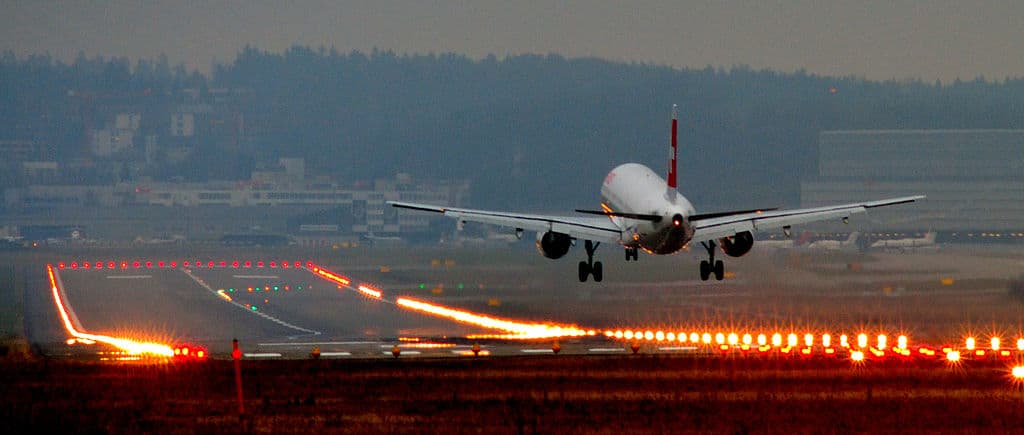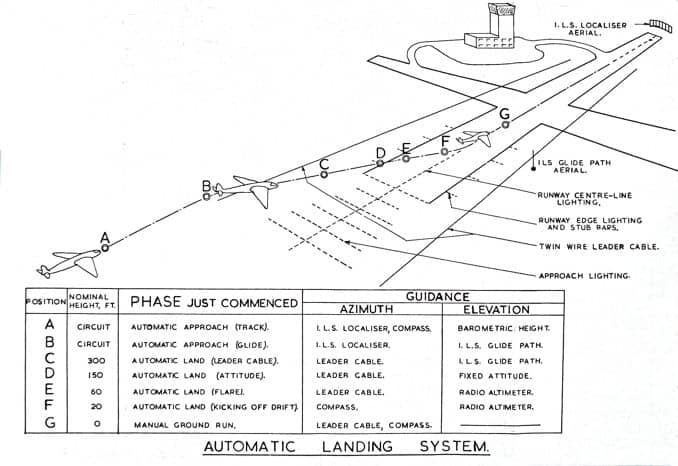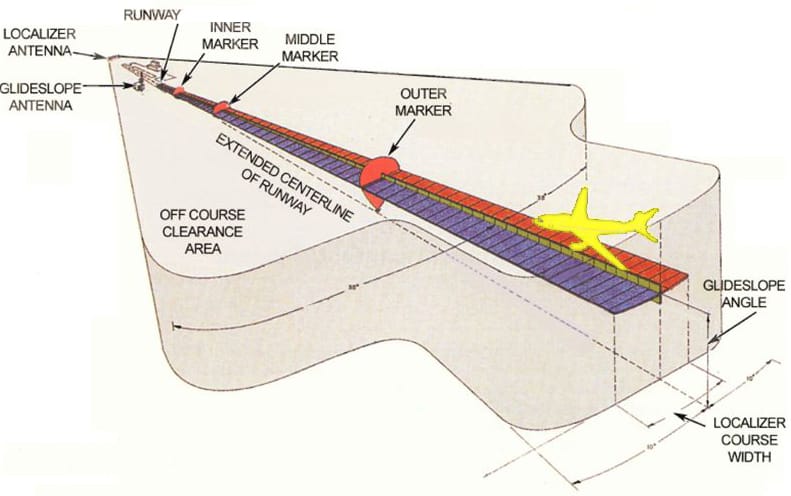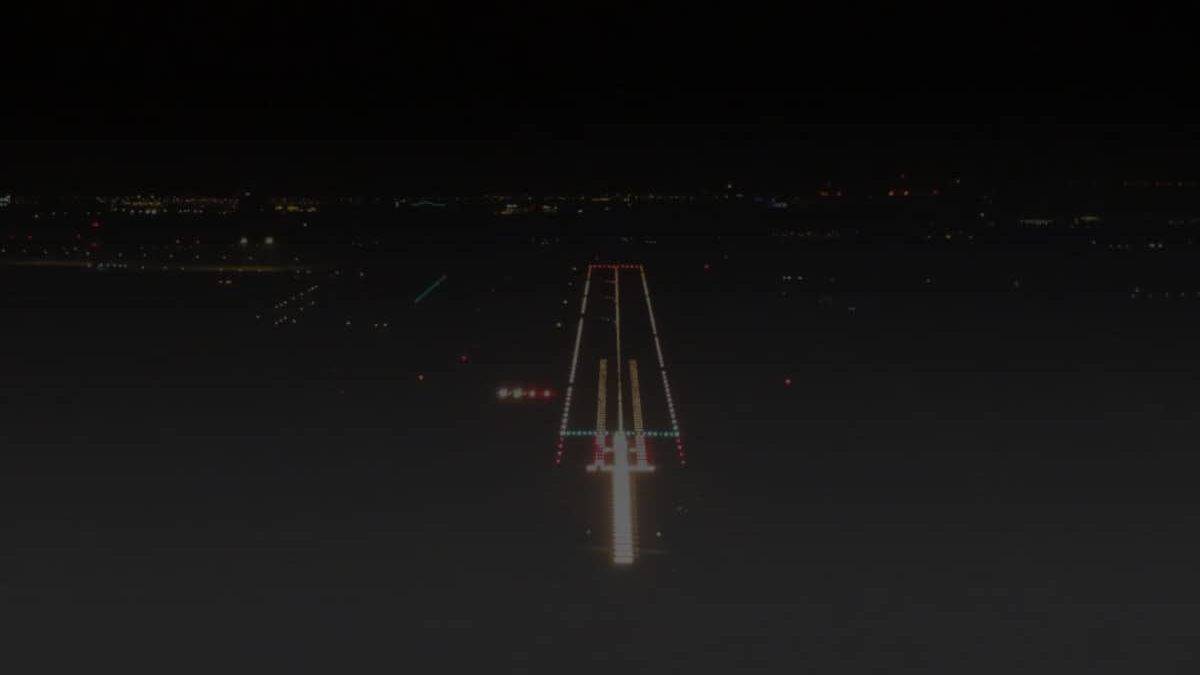
Have you ever looked out of the window of an airplane and not been able to see anything beyond the wing and then all of a sudden the airplane lands? If you couldn’t see anything how could the pilots? There is obviously some magic and technology that allows the aircraft to safely land when the visibility is poor but what is it?
Most modern commercial airplanes are fitted with an autoland capability that uses sensors, GPS, and navigation data to fly the airplane down a runway’s instrument landing system and then automatically land without any pilot manipulation. The systems are used rarely and only at suitably equipped airports.
Diversions are costly to airlines and when the visibility starts to drop airlines need the aircraft to land as normal to help prevent delays and their associated costs. For this reason, many modern airplanes are fitted with an autoland capability that allows landing even down to conditions that make the pilots nervous!
What is Autoland?
Autoland is a digital system built into aircraft avionics that allows the airplane to descend, decelerate and land smoothly without any pilot manipulation of the controls. It is used when visibility is below 300 meters or 1,000 feet and the airport and aircraft are certified for its use.
The system is mainly used when weather conditions are too poor for the pilots to make a manual approach to the runway. Pilots need time to see the airport’s approach lighting system and runway to adjust the flight profile for touchdown. Without sufficient time, pilots can land the aircraft hard onto the runway surface causing damage.
The autoland system does not require visual cues to adjust the flight profile as it uses sensors and telemetry data to know exactly where the aircraft is in relation to the runway and ground and will start to adjust the profile based on that data.
How Does the Autoland System Work?
Autoland works through independent autopilot systems on the aircraft. The autopilots receive information about the plane’s position and height in relation to the runway’s centreline and the ground respectively. Using this information, the autopilot systems adjust the flight controls and maneuver automatically toward the runway, and makes a landing by itself.

Information on the plane’s position in relation to the runway is provided by the Instrument Landing System (ILS). ILS is a ground-based system that includes:
- The Localizer: This transmits radio signals that provide lateral guidance to a plane so that it can be centered on the runway at touchdown.
- Glideslope: This provides vertical guidance to a plane so that it can maintain a 3° vertical descent profile.

Height data is also confirmed using a Radio Altimeter. This device acts similarly to the sonar on a submarine. It sends a radio pulse out of an antenna mounted on the belly of the aircraft and the time it takes for the signal to leave and bounce back off the ground is then used to calculate the height of the aircraft above the terrain.
The autoland system takes in the data from all the sensors and adjusts the flight controls via the autopilots to ensure the aircraft is in the position it is supposed to be at that exact moment. The autoland system completes this position check multiple times per second and adjusts accordingly.
Wind, turbulence, and atmospheric conditions constantly nudge the aircraft off its assigned trajectory and the autopilots correct instantly. The software behind the autoland system knows when to activate certain functions on the aircraft based on its position. These functions are speed control, flare for touchdown, braking etc.

Join My Newsletter & Get Great Tips, Information and Experiences To Help You Become a Superb Pilot!
The autoland system has to be activated by the pilots and also configured in the FMS (Flight Management Computer) for the runway they are about to descend for. Once the autoland system has been activated the pilots monitor the aircraft instrumentation to ensure the system is positioning the aircraft correctly and that it initiates the correct actions at the correct times.
If the pilots find the autoland system is not maintaining the correct flight profile or a malfunction develops they instantly deselect the autoland function and perform a go-around that terminates the approach and climbs away from the ground for safety.
Learn More…
Try These Articles:
* How Do Pilots See At Night? Everything You Want To Know!
* Do Helicopters Have Autopilots?
What are the Types of Autoland Systems?
Automatic landing systems are categorized into two types. Depending on the sophistication of the avionics installed on the aircraft will dictate which system type is installed. The type systems types are:
- Fail Passive
- Fail Operational
Both of these systems require the aircraft to contain more than one autopilot system that functions independently but communicates with each other. This is a redundancy measure in case one fails.
Fail Passive:
A Fail Passive automatic landing system causes little to no deviation in case one autopilot malfunctions, say, one autopilot receives wrong data from the systems it is dependent on and gives wrong control inputs to the plane.
The non-malfunctioning autopilot will then continue to control the plane and disconnect the malfunctioning autopilot. There is no need to re-trim the airplane and the pilots will take manual control.
A fail passive system is annunciated as “LAND 2” on the Primary Flight Displays of each pilot. This system requires:
- 2 independent autopilots capable of following ILS signals;
- 2 independent navigation systems capable of tuning to the ILS frequency of the active runway and providing navigation information to its own autopilot, and
- 2 independent radio altimeters to give the accurate height of the airplane above ground level to each autopilot.
Fail passive systems usually do not have a rollout mode and, therefore, the autopilot is disengaged after touchdown and the airplane is steered down the runway and taxied manually by the pilots.
Fail Operational:
A Fail Operational system is one where the failure of one autopilot does not inhibit the system from fully carrying out the automatic landing by itself. This requires more than two independent autopilots, usually three. Fail operational is annunciated as “LAND 3”. When one autopilot fails, the system becomes fail passive and is annunciated as “LAND 2”.
When is Autoland Used?
The capabilities of the autoland system depend on the type of Instrument Landing System (ILS) category installed for the active runway. Not all airports can accommodate the necessary infrastructure to allow for aircraft to autoland.
Autoland is utilized when the forward runway visibility drops below 1000ft/300m and the instrument landing system for that runway is of at least a Category III and low visibility operations are in effect and autoland is approved by air traffic control. Pilots can then elect to activate the system.
The runway’s Instrument Landing system is split up into several categories depending on its capabilities during low visibility operations. Each category stipulates the visibilities at which it can operate down to and is based on Decision Heights and Runway Visual Ranges.
- Decision Height (DH): – The minimum height during the final approach at which a decision to land or go around is made depends on whether adequate external visual references have been obtained by the pilots
- Runway Visual Range (RVR): – The distance down a runway in which a pilot on the centreline of that runway can see runway markings or lights delineating the surface of the runway.
Based on these two parameters the minimum requirements for different ILS categories are:
| DH (feet) | RVR (feet) | |
| Cat I | 200 | >1,800 |
| Cat II | 100-200 | >1,000 |
| Cat IIIA | <100 | >700 |
| Cat IIIB | <50 | 150 – 700 |
| Cat IIIC | 0 | 0 |
Most autoland operations are active when the weather conditions drop near to zero and a Cat IIIB & IIIC ILS are required. The time required for a pilot to see the runway and safely land justifies the need for the autoland systems to begin adjusting the aircraft before visual cues are received by the pilot.

How Often Do Pilots Use Autoland?
Very few landings are completed by autoland as the poor weather conditions only exist at certain airports at certain times of the year. Pilots practice autoland operations regularly but actual autolandings are very rare. Pilots always prefer to hand fly the landings to ensure safety and smoothness.
Some pilots say that in their 40 years of flying, they have only done a dozen autolands. Others say they do it 4-5 times a month during winter months in Europe. It all depends on the routes the pilots commonly fly and the capabilities of the ILS systems of the airports they fly into.
Pilots rarely prefer autoland as it tends to do a firm landing, contrary to humans who come in for a smooth landing. Pilots also have to constantly practice their flying skills as there is no guarantee that you will always have autoland in different airports. Weather conditions such as 10 knots crosswinds for most airlines and the presence of wind shear will also prevent the pilots from using autoland.
What is the Procedure for Autolanding a Boeing 737?
The B737 is fail passive and a summary of a typical autoland procedure is as follows:
- The First Officer becomes the pilot flying, if they weren’t already, and the Captain assumes the pilot monitoring role. These roles are temporary and only for the approach phase.
- Activate the ILS approach for the runway using the Flight Management Computer and enter the ILS frequency on the navigation radios of both the Captain and First Officer.
- Level off at 3,000 feet by the time you are about 15 miles out from the runway to capture the Glideslope from below. Arm ‘Approach’ mode and engage the second autopilot. Approach mode is used to capture and fly an ILS approach.
- When the Localizer and Glideslope signals are within the plane’s reach, the autopilots maneuver the plane to capture them. This will center the plane on the runway centreline and give it a Glideslope profile of about 3°.
- At 1,000 feet, the plane must be fully configured for landing and the landing checklist complete. If not, a go-around is initiated. 800 feet Radio Altitude is the last point the 2nd autopilot must be engaged. If not engaged below this, a go-around is initiated.
- At 500 feet, the Captain confirms that flare mode is armed. At 400 feet, the plane trims in preparation for a flare or go-around.
- At 50 feet, the Captain, who has been scanning for external visual references like a segment of the approach lighting system, makes a decision to land or not. If visual references are adequate, he will call out “Land”, physically remove the First Officer’s hand from the throttles and assume the pilot flying role.
- At touchdown, the autopilot disconnects, the Captain manually deploys reverse thrusters, brakes the plane, and steers it down the runway.
Learn More…
Try These Articles:
* Finding the Right Runway: How Do Pilots Know Where To Land?
* Black Box Flight Recorders: Do Helicopters Have Them?

